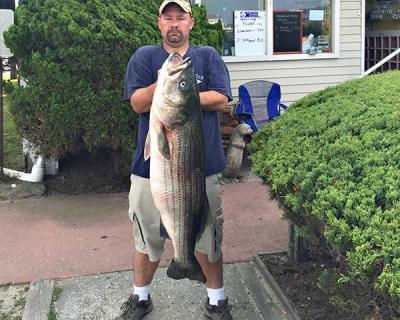We Are Predators and Prey

I had lunch at the Inlet Seafood restaurant in Montauk on Monday afternoon. There were five of us, one of whom pulled out his smartphone as we waited with delicious anticipation for sushi, mussels, and broiled mahi sandwiches.
Then one of the lunch mates, an experienced captain of a sportfishing boat, pulled out his smartphone, searched up a video that was going viral, and passed it around. The small screen displayed a very big white shark taking bushel basket-sized bites from a dead and floating humpback whale off Long Beach a few days ago. It was an impressive display of appetite that took away a little of my own. “Wow,” gravely spoken, was the unanimous reaction to the visual.
Conversation naturally flowed to the story of the fisherman competing in last weekend’s shark tournament held from the Star Island Yacht Club and Marina whose hand was bitten by a shark, a serious injury that required surgery. Apparently the angler was standing close to a mako that had been hauled up on the boat’s gin pole, face down, of course. The shark had been hanging for some time — according to scuttlebutt that scuttled around Montauk at lightning speed — but came back to life upon glimpsing the fisherman’s hand, and chomp!
The story, related by the same member of our party who had passed around the white shark video, was met with several minutes of guffawing, all present in agreement that what goes around comes around, all’s fair in love and fishing tournaments, with similar oblations to karmic justice. The back-to-back reactions proved once again that our relationship to sharks is as complicated as it is fascinating.
Sharks have been attacking of late. Three young swimmers were bitten in the past month on the East Coast, two in North Carolina, one in Florida. These were most likely cases of mistaken identity, the attackers mistaking the kids for other types of prey, turtles perhaps.
But, the bites, the viral video of white-shark power, the fact that Cape Cod beaches had to be closed during the past few summers due to cruising Jaws, jogs an ancient truth deep down in our subconscious, brings it right up to the surface. We are prey, given circumstances that are more common (we like to surf, boogie board, swim) than, say, taking a stroll in bear country.
That’s our instinctual response, but we are rational beings (sort of) and so we tend to laugh off the survival instinct, as long as it’s not our own, because we know that sharks bite because that’s how they live, and we admire them for it.
Here’s the question: If the angler who got his hand bitten had been competing in a no-kill shark tournament, like the upcoming Carl Darenberg Memorial Shark’s Eye tournament scheduled to be held from the Montauk Marine Basin on July 17, would my lunch mates’ reaction have been the same? I don’t think so. I think we might have felt sorry for the man for his greenery.
In any case, the winner of the Star Island tournament was the Whitewater boat that brought back a 470-pound mako. Two other hefty makos won those who angled them second and third-place honors. A 349-pounder was taken by the Overspray, and the Lady Irene hoisted a 334-pound mako for third. Blue sharks and threshers were also brought to the scales.
Also caught, by surprise, during the shark tournament were a number of bluefin tuna passing through on their northerly migration. The tuna are said to be in the 50 to 150-pound range, a school or schools stretching from Shinnecock east to southern New England. They have been feeding on sand eels, a mass of which swarmed close to shore in recent days, but have moved off, Paul Apostolides of Paulie’s Tackle shop in Montauk said on Tuesday morning.
Standings in the Montauk SurfMasters Spring Shootout tournament that ends on July 4 were as follows as of early Tuesday: Gary Krist remains in first place with a 42.08-pound striper, Paul Pira’s 36.1-pound bass holds the second position, with Wes O’Donnell in third place with a 28.86-pound striped bass.
Harvey Bennett of the Tackle Shop in Amagansett reports, “They’re all over the place up here,” meaning 8-to-10-pound striped bass along the south-facing beaches, as well as small bluefish. Gardiner’s Bay, especially Cherry Harbor on the west side of Gardiner’s Island, is alive with porgies, Bennett said.
He claims he’s been working with Stuart Vorpahl of East Hampton on cloning a giant “horsefoot” (that’s Bonac for horseshoe crab) in Accabonac Harbor.
“It’s going well with the help of the grays,” he said, explaining, for those, including me, who are not in that particular loop, that “grays” are extra-terrestrials.
Uh-huh. I’m getting that prey-like feeling.
